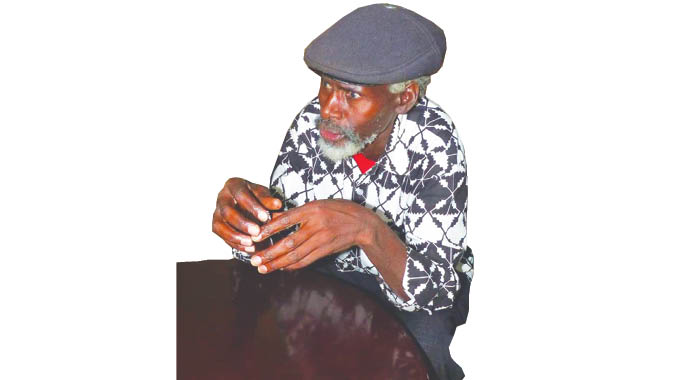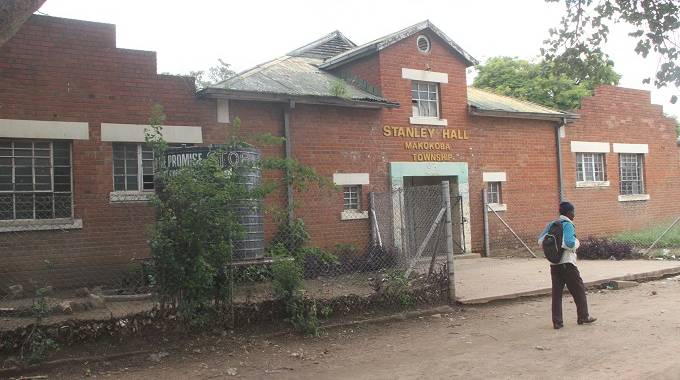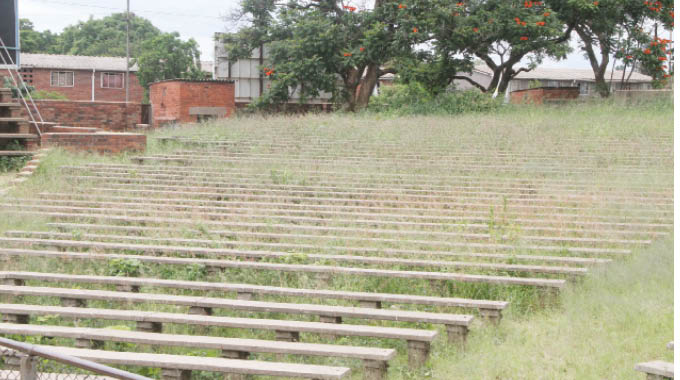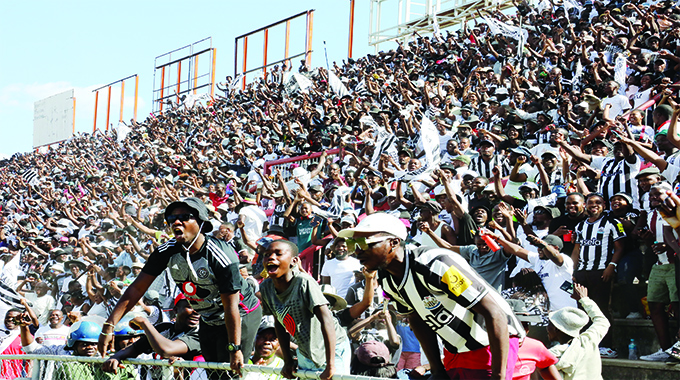Decay of Bulawayo heritage and recreational sites under spotlight

Nduduzo Tshuma, Political Editor
Bulawayo City Council and residents in general have a duty to preserve heritage sites dotted around the city as part of capturing the country’s liberation history, veteran playwright and founder of Amakhosi Cultural Centre Cont Mhlanga has said.

Stanley Hall
Mr Mhlanga said as Bulawayo welcomes the decision by the Government to devolve the holding of the main programme of the Independence Day Celebrations, the first time it is held outside Harare since 1980, the preservation of liberation heritage sites and narrative will add much weight to the event.
Bulawayo was chosen to host this year’s main celebrations to be held at the Barbourfields Stadium.
However, concern has been raised over the state of disrepair in institutions associated with the country’s liberation struggle such as the Stanley Hall and Stanley Square among others, coupled with a lack of narrative to preserve the liberation history.

The dilapidated Stanley Square in Makokoba
Mr Mhlanga, however, said there was hope after the Government introduced the new education competence-based curriculum that emphasises on the need to record the country’s liberation history.
“Bulawayo was built on the strength of culture, heritage and recreation. That’s why if you go to every suburb, you find a recreational club, in all suburbs there is a library, youth centre and a hall. It shows you that there was a strong sense of heritage and the teaching of young people,” said Mr Mhlanga.

He lamented that years of neglect have seen such halls and recreational centres lying in a state of disrepair while libraries are filled with donated books that do not carry the country’s heritage.
“It means that the children are now reading the wrong content, it’s no longer the content that captures the memory of the local people but imposed content. This means that all Bulawayo heritage memory starts to suffer,” said Mr Mhlanga.
He said there were many heritage centres that have either been neglected or totally ignored by the local authority.
“Here where we are seated (Amakhosi Cultural Centre) is a heritage site, because this is where the Inxwala Festival was held but there is no documentation. The river in front of us, Bulawayo Spruit (Mazayi) is a heritage site, it was the boundary that the blacks were restricted to when whites invaded here and took over what is present day State House, the blacks were made squatters, that is the impact of colonisation,” said Mr Mhlanga.
“Blacks initially stayed as squatters where there is present day Khumalo Barracks right up to Mahatshula but when the whites started pegging for Suburbs, they felt the blacks were too close and drove them to here. They were made to stay between Mazayi and that stream that passes through McKeurtan Primary School, that was the first black settlement in 1893, the two streams meet behind St Columbus High School.”
Mr Mhlanga said the Stanley Square and Stanley Hall, also iconic liberation institutions, were built within the boundaries of that first black location.
“If our own city fails to then take care of these two streams and make sure that everything within these two streams is well preserved to the dot then what will we be preserving?” said Mr Mhlanga.
He said if he was designing the Independence Day celebrations, the procession on the day would start from Stanley Square to BF using 6th Street, which used to be Taylor Street.
“That is the place that remained the location of Africans from 1893, it is where the liberation and urbanisation for Africans came from. If we don’t put this narrative for our children then what are we doing,” said Mr Mhlanga.
“At Renkini, it was called Egodini leziNgwenya in the 1930’s where bare knuckle fights were held. The men from the 1890s, the 20-year olds were fighting in defiance of the white man who destroyed their Kingdom and they were now meeting on the island to fight.
“The dry fist fights were the expression of anger since they could no longer fight in warfare as they were restricted to that island. They could not cross Mazayi as it was a farm (Curtis Farm) belonging to whites, they could not cross the other stream at McKeurtan Primary School as that was now the town belonging to the white man.”
Mr Mhlanga said the whites-built Stanley Square developing from the concept of Egodini lezi Ngwenya and closed the arena at present day Renkini.
“That’s why Stanley Square became a 25 000-seater because those fights attracted a lot of people and they were not fighting for any reward but to blow off steam until the whites found away to exploit them. Whites from South Africa would come to take fighters to fight World War 2 prisoners and other criminals from Europe were also brought here for prize fighting. Members of the white police later joined the fights, the blacks couldn’t use spears so they lured the white policemen to those fights.
“There were multi-millionaires in the 1920s to 1940s because of this dry fist fighting.”
Mr Mhlanga said it was the duty of the City of Bulawayo and its residents to preserve the memory of the liberation. “It can’t be central Government, we have to persuade the city of Bulawayo to understand that Makokoba, the whole of it is heritage, it is the story of urbanisation for Africans after colonisation. We can’t talk of liberation without the mention of Makokoba, everything started here,” said Mr Mhlanga.
“So, what are we doing as council and local Government if we can’t spend a dollar, if we say we are broke to preserve our own national memory and history, we can’t be broke to a point we chose to rub who we are. This is where our children,” he said.
“Bulawayo is the responsibility of everyone regardless of political affiliation, it’s their responsibility to preserve the memory of the city, we cannot destroy the memory of a city and be proud to host the 40th Independence Celebrations.”
He said it was not a mistake that the Vundu Hostels were built close to Stanley Square.
“That’s where the life was and the centre of it all but to live there, there were many conditions like the town pass among other things. That is why later when (trade unionist and nationalist) Benjamin Burombo said that is owned by whites and shutting our people out. He built Burombo Flats, exactly the same in design like Vundu beyond Mazayi the colonial boundary, that was very symbolic and that narrative needs to be told,” said Mr Mhlanga. “If you want to understand the struggle of a black person after colonisation and how it started off in the 1900 to 1920s and how it was built up until it became the liberation struggle that we are celebrating. If you go to Stanley Square and look at the sitting arrangements, there is a closed circuit fence, that is where the whites sat betting for white criminals fighting Izingwenya that was the anti-colonial resistance wars being transformed into an urban sport an culture and then being transformed into a war of resistance.”
Mr Mhlanga said when the intellectuals started the liberation struggle, they chose Stanley Hall and Stanley Square as their meeting point carrying forward the spirit of resistance. “That is when Burombo bought land on the other side of Mazayi, land owned by the white man to accommodate blacks. If we don’t declare and maintain Burombo’s legacy we would have done a major injustice, have you been there? You will be shocked! these are the areas that should be named as heritage sites. These are the places our city should be taking over and proper care of. We should be creating a history library there because the guy was literary assassinated by the whites at the hospital because he was fighting for Africans to have land the same land today the whites want compensation for,” said Mr Mhlanga.
“Burombo died defending the people, he went on to build that flat and what are we doing to preserve his legacy? we should do something really this is our legacy.”
Mr Mhlanga called for the erection of liberation struggle war memory centers to capture the liberation narrative from 1893 to the days of the nationalist movement.
“The liberation struggle starts the moment we were colonised in 1893 right up to the nationalist movement. If we do not dig that information now when people who lived during that time (nationalist movement) are still alive, we will never have this information. The generation from that era are dying and we have to get that information from them before they all die otherwise, we will be left with nothing,” said Mr Mhlanga.
On their part, Mr Mhlanga said they had partnered with a local tertiary institution to build a digital library at Amakhosi where researchers will access information on the country’s liberation heritage.








Comments